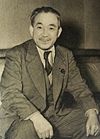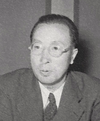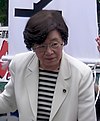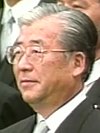Japan Socialist Party
Japan Socialist Party 日本社会党 Nippon shakai-tō or Nihon shakai-tō | |
|---|---|
far-left[B] | |
| International affiliation | Socialist International[4] |
| Colors | Blue |
| Party flag | |
 | |
^ A: Right Socialist Party of Japan ^ B: Left Socialist Party of Japan | |
The Japan Socialist Party (日本社会党, Nihon Shakai-tō,
The JSP was briefly in power from 1947 to 1948. From 1951 to 1955, the JSP was divided into the
In the late 1980s and early 1990s, the JSP under the leadership of Takako Doi earned a record-high number of seats. However, the establishment and electoral success of new conservative parties in the mid-1990s took the JSP by surprise and its share of seats in the National Diet decreased significantly. The party was formally dissolved in 1996. Its successor is the Social Democratic Party, a minor party holding two parliamentary seats, one each in the Houses of Representatives and Councillors as of 2022.[8]
Two
History
1940s
The party became the largest political party in the first general election under the
In the period following the end of World War II, the JSP played a key role in the drafting of the new Japanese constitution, adding progressive articles related to issues such as health, welfare and working conditions.
1950s
The Showa Denko scandal not only brought the downfall of the cabinet, but also led to an acrimonious schism between the left and right halves of the Socialist Party amid mutual recriminations, as one of the main targets of the investigation had been Right Socialist faction leader
In 1955, the two splinter parties begrudgingly set aside their differences and re-merged. This was a "shotgun wedding" of sorts that happened under duress as it became increasingly clear that all of the conservative parties, with U.S. backing, were in the process of merging to form what would become the
1960s
The party split again in 1960 because of internal disagreement over how to conduct the ongoing
A further blow came in the fall of 1960 when the energetic JSP party chairman
In particular, Eda earned the enmity of the party's left-wing due to his ambitious platform of "structural reform" (構造改革, kōzō kaikaku) and his related "Eda Vision" of socialism.
In an effort to build popular support for his reform program, Eda announced his "New Vision of Socialism", better known by its nickname, the "Eda Vision", in July 1962.[25] Eda declared that "[s]ocialism must be defined in sunny and cheerful terms that are easily understandable to the masses. I believe that 'socialism' is that which allows human potential to blossom to its fullest extent. The main four accomplishments that humankind has achieved so far are America's high standard of living, the Soviet Union's thoroughgoing social welfare system, England's parliamentary democracy, and Japan's peace constitution. I believe that if we can integrate these, we can give birth to a broad-based socialism."[25]
The "Eda Vision" of a more moderate form of socialism was received enthusiastically in the mainstream Japanese press, and polled well in public opinion polls.
Thereafter, a younger generation of reform-minded activists became disillusioned and began to drift away from the party.
1970s
In some regions, the party continued to perform well at the local level and by the 1970s many areas were run by JSP (or JSP-backed) mayors and governors, who supported environmental protection initiatives and introduced new social welfare programs.[28][29][30][31][32][33][34]
Meanwhile, Saburō Eda continued his efforts to reform the party and expand its base. Eda ran numerous times for the post of party chairman, but was unsuccessful, although he did serve a second stint as Secretary General from 1968 to 1970. Nevertheless, Eda remained popular among the broader Japanese public and in the mid-1970s conservative prime minister Kakuei Tanaka said at a press conference, "If the Japan Socialist Party were ever to make Eda its Chairman again, a general election would be terrifying. They would drastically expand their seats in the Diet."[35] Eda could never overcome the undying animosity his "Eda Vision" had won him from his party's left-wing.[citation needed]
In 1976, Eda lost his reelection bid and was booted from the Diet. Blaming his loss on his party's dogmatic, doctrinaire Marxism and desperate for reform, he attempted to resign from the JSP but the party refused to accept his resignation and voted to expel him instead. The following year, Eda and Hideo Den (田英夫) led a small group of JSP Dietmembers to split from the JSP and form a new party called the Socialist Democratic Federation (社会民主連合).[36][37]
1980s
In July 1986, under party chairman Masashi Ishibashi, the JSP suffered a disastrous double defeat in both houses of the National Diet in the simultaneously held 1986 Japanese general election and 1986 Japanese House of Councillors election. Losing in a rout to the Liberal Democratic Party (LDP) under popular prime minister Yasuhiro Nakasone, the JSP's seats in the lower house fell from 112 to a new all-time low of 85 and its share of the popular vote dropped from 19.5 percent to 17.2 percent. This defeat led the party to elect Takako Doi as party chair, making her the first woman to ever lead a Japanese political party. Doi was popular with the Japanese public led the JSP to an electoral comeback with an impressive showing in the 1990 Japanese general election, winning 136 seats and 24.4 percent of the vote. Some electoral districts had more than one successful socialist candidate. Doi's decision to put up more than one candidate for each of the 130 districts represented a controversial break with the past because unlike their LDP counterparts many party candidates did not want to run against each other; however, the great majority of the 149 socialist candidates who ran were successful, including seven of eight women.[citation needed]
Doi, a university professor of constitutional law before entering politics, had a tough, straight-talking manner that appealed to voters tired of the evasiveness of other politicians. Many women found her a refreshing alternative to submissive female stereotypes and in the late 1980s the public at large in opinion polls voted her their favorite politician (the runner-up in these surveys was equally tough-talking conservative LDP member
In 1983, Doi's predecessor as chairman
Doi expressed support for balanced ties with the Democratic People's Republic of Korea (
Because of the party's self-definition as a class-based party and its symbiotic relationship with the General Council of Trade Unions of Japan (Sōhyō), the public-sector workers' confederation, few efforts were made to attract non-union constituencies. Although some Sōhyō unions supported the Japanese Communist Party, the party remained the representative of Sohyo's political interests until the merger with private-sector unions and the Japanese Trade Union Confederation (Rengō) in 1989. Because of declining union financial support during the 1980s, some party Diet members turned to dubious fund-raising methods. One was involved in the Recruit affair. Like other parties, it sold large blocks of fund-raising party tickets and the LDP even gave individual party Diet members funds from time to time to persuade them to cooperate in passing difficult legislation.[citation needed]
1990s
As part of the fallout of the
The JSP then formed a grand coalition (dai-renritsu) government with the LDP and the New Party Sakigake under JSP Prime Minister Tomiichi Murayama, who was leader of the party from 1993 to 1996. Most of the other parties from the anti-LDP coalition, now forced back into opposition, united to form the New Frontier Party (NFP), which overtook the JSP as second largest political party in Japan. The JSP suffered a defeat in the 1995 Japanese House of Councillors election. In January 1996, the New Socialist Party of Japan split off from the JSP, Murayama resigned as Prime Minister, and the JSP changed its name from the JSP to the Social Democratic Party (SDP) as an interim party for forming a new party.[citation needed]

Ideology
The JSP is generally regarded as having been a progressive "
The JSP supported a neutralist
After
The JSP opposed Shintoist social conservatism, and was politically friendly with Christianity in the United States. There were quite a few Christians in the JSP. Former Japanese Prime Minister Tetsu Katayama was also a Christian.[47]
The party interacted with the
Leaders
| No. | Photo | Name (Birth–death) |
Constituency / title | Term of office | Election results | Prime Minister (term) | ||
|---|---|---|---|---|---|---|---|---|
| Took office | Left office | |||||||
| Chair of the Social Democratic Party of Japan (1946–1950) | ||||||||
| 1 |  |
Tetsu Katayama (1887–1978) |
Rep for Kanagawa 3rd |
28 September 1946 | 16 January 1950 | — | Yoshida 1946–47 | |
| himself 1947–48 | ||||||||
| Ashida 1948 | ||||||||
| Yoshida 1948–54 | ||||||||
| Chair of the Social Democratic Party of Japan, Right (1951–1955) | ||||||||
| — |  |
Jōtarō Kawakami (1889–1965) |
Rep for Hyogo 1st |
19 January 1951 | 12 October 1955 | — | Yoshida 1948–54 | |
| Hatoyama I. 1954–56 | ||||||||
| Chair of the Japanese Socialist Party, Left (1951–1955) | ||||||||
| — |  |
Suzuki Mosaburō (1893–1970) |
Rep for Tokyo 3rd |
18 January 1951 | 12 October 1955 | — | Yoshida 1948–54 | |
| Hatoyama I. 1954–56 | ||||||||
| Chair of the Social Democratic Party of Japan, Unified (1955–1996) | ||||||||
| 2 |  |
Suzuki Mosaburō (1893–1970) |
Rep for Tokyo 3rd |
12 October 1955 | 23 March 1960 | — | Hatoyama I. 1954–56 | |
| Ishibashi 1956–57 | ||||||||
| Kishi 1957–60 | ||||||||
| 3 |  |
Inejiro Asanuma (1898–1960) |
Rep for Tokyo 1st |
23 March 1960 | 12 October 1960 (assassinated) |
1960
Inejirō Asanuma – 228 Jōtarō Kawakami – 206 |
||
| Ikeda 1960–64 | ||||||||
| — |  |
Saburō Eda (1907–1977) (acting) |
Cou for Okayama at-large |
12 October 1960 | 6 March 1961 | — | ||
| 4 |  |
Jōtarō Kawakami (1889–1965) |
Rep for Hyogo 1st |
6 March 1961 | 6 May 1965 | — | ||
| Satō 1964–72 | ||||||||
| 5 |  |
Kouzou Sasaki (1900–1985) |
Rep for Miyagi 1st |
6 May 1965 | 19 August 1967 | January 1966
Kozo Sasaki – 295 Saburō Eda – 276 December 1966
Kozo Sasaki – 313 Saburō Eda – 274 |
||
| 6 |  |
Seiichi Katsumata (1908–1989) |
Rep for Shizuoka 2nd |
19 August 1967 | 4 October 1968 | — | ||
| 7 |  |
Tomomi Narita (1912–1979) |
Rep for Kagawa 1st |
30 November 1968 | 26 September 1977 | 1970
Tomomi Narita – 207 Saburō Eda – 148 |
||
| Tanaka K. 1972–74 | ||||||||
| Miki 1974–76 | ||||||||
| Fukuda T. 1976–78 | ||||||||
| 8 |  |
Ichio Asukata (1915–1990) |
Rep for Tokyo 1st |
13 December 1977 | 7 September 1983 | 1981
Ichio Asukata – 39379 Sanji Mutō – 14721 Shōichi Shimodaira – 3425 |
||
| Ōhira 1978–80 | ||||||||
| Ito 1980 (Acting) | ||||||||
| Suzuki Z. 1980–82 | ||||||||
| Nakasone 1982–87 | ||||||||
| 9 |  |
Masashi Ishibashi (1924–2019) |
Rep for Nagasaki 2nd |
7 September 1983 | 8 September 1986 | — | ||
| 10 |  |
Takako Doi (1928–2014) |
Rep for Hyogo 2nd |
9 September 1986 | 31 July 1991 | 1986
Takako Doi – 58670 Tetsu Ueda – 11748 |
||
| Takeshita 1987–89 | ||||||||
| Uno 1989 | ||||||||
| Kaifu 1989–91 | ||||||||
| 11 | Makoto Tanabe (1922–2015) |
Rep for Gunma 1st |
31 July 1991 | 19 January 1993 | 1991
Makoto Tanabe – 46363 Tetsu Ueda – 36358 |
|||
| Miyazawa 1991–93 | ||||||||
| 12 |  |
Sadao Yamahana (1936–1999) |
Rep for Tokyo 11th |
19 January 1993 | 25 September 1993 | — | ||
| Hosokawa 1993–94 (coalition) | ||||||||
| 13 |  |
Tomiichi Murayama (b. 1924) |
Rep for Ōita 1st |
25 September 1993 | 19 January 1996 | 1993
Tomiichi Murayama – 65446 Masatoshi Ito – 18075 1996
Tomiichi Murayama – 57591 Tadatoshi Akiba – 10440 |
||
| Hata 1994 | ||||||||
| himself 1994–96 | ||||||||
| Hashimoto 1996–98 (coalition, confidence and supply) | ||||||||
| Successor party: Social Democratic Party (centre-left to left-wing) | ||||||||
Election results
General election results
| Election | Leader | Seats | Position | Constituency votes | Status | |||
|---|---|---|---|---|---|---|---|---|
| No. | ± | Share | Number | % | ||||
| 1946 | Tetsu Katayama | 92 / 468
|
19.6% | 3rd | 9,924,930 | 17.90% | Opposition | |
| 1947 | Tetsu Katayama | 143 / 466
|
30.7% | 7,176,882 | 26.23% | JSP-DP-NCP coalition (until 1948) | ||
| Opposition (since 1948) | ||||||||
| 1949 | Tetsu Katayama | 48 / 466
|
10.3% | 4,129,794 | 13.50% | Opposition | ||
| 1952 | Jōtarō Kawakami Mosaburō Suzuki |
111 / 466
|
23.8% | 7,507,842 | 21.24% | Opposition | ||
| 1953 | Jōtarō Kawakami Mosaburō Suzuki |
138 / 466
|
29.6% | 9,194,547 | 26.57% | Opposition | ||
| 1955 | Jōtarō Kawakami Mosaburō Suzuki |
156 / 467
|
33.4% | 10,812,905 | 29.21% | Opposition | ||
| 1958 | Mosaburō Suzuki | 166 / 467
|
35.5% | 13,093,993 | 32.94% | Opposition | ||
| 1960 | Saburō Eda | 145 / 467
|
31.0% | 10,887,134 | 27.56% | Opposition | ||
| 1963 | Jōtarō Kawakami | 144 / 467
|
30.8% | 11,906,766 | 29.03% | Opposition | ||
| 1967 | Kōzō Sasaki | 140 / 486
|
28.8% | 12,826,104 | 27.88% | Opposition | ||
| 1969 | Tomomi Narita | 90 / 486
|
18.5% | 10,074,101 | 21.44% | Opposition | ||
| 1972 | Tomomi Narita | 118 / 491
|
24.0% | 11,478,142 | 21.90% | Opposition | ||
| 1976 | Tomomi Narita | 123 / 511
|
24.1% | 11,713,009 | 20.69% | Opposition | ||
| 1979 | Ichio Asukata | 107 / 511
|
20.9% | 10,643,450 | 19.71% | Opposition | ||
| 1980 | Ichio Asukata | 107 / 511
|
20.9% | 11,400,748 | 19.31% | Opposition | ||
| 1983 | Masashi Ishibashi | 112 / 511
|
21.9% | 11,065,083 | 19.49% | Opposition | ||
| 1986 | Masashi Ishibashi | 85 / 512
|
16.6% | 10,412,584 | 17.23% | Opposition | ||
| 1990 | Takako Doi | 136 / 512
|
26.6% | 16,025,472 | 24.39% | Opposition | ||
| 1993 | Sadao Yamahana | 70 / 511
|
13.7% | 9,687,589 | 15.43% | JSP-Komeito-JRP-JNP-DSP-NPS-DRP-SDF coalition (until 1994) | ||
| LDP–JSP–NPS coalition (until 1996) | ||||||||
Councillors election results
| Election | Leader | No. of seats total |
No. of seats won |
No. of National votes |
% of National vote |
No. of Prefectural votes |
% of Prefectural vote | |
|---|---|---|---|---|---|---|---|---|
| Japanese Socialist Party era | ||||||||
| 1947 | Tetsu Katayama | 47 / 250
|
3,479,814 | 16.4% | 4,901,341 | 23.0% | ||
| 1950 | Tetsu Katayama | 61 / 250
|
36 / 125
|
4,854,629 | 17.3% | 7,316,808 | 25.2% | |
| 1953 | Mosaburō Suzuki | 66 / 250
|
28 / 125
|
5,559,875 | 20.7% | 6,870,640 | 24.5% | |
| 1956 | Mosaburō Suzuki | 80 / 250
|
49 / 127
|
8,549,940 | 29.9% | 11,156,060 | 37.6% | |
| 1959 | Mosaburō Suzuki | 85 / 250
|
38 / 127
|
7,794,754 | 26.5% | 10,265,394 | 34.1% | |
| 1962 | Jōtarō Kawakami | 66 / 250
|
37 / 127
|
8,666,910 | 24.2% | 11,917,675 | 32.8% | |
| 1965 | Kōzō Sasaki | 73 / 251
|
36 / 127
|
8,729,655 | 23.4% | 12,346,650 | 32.8% | |
| 1968 | Tomomi Narita | 65 / 250
|
28 / 126
|
8,542,199 | 19.8% | 12,617,680 | 29.2% | |
| 1971 | Tomomi Narita | 66 / 249
|
39 / 125
|
8,494,264 | 21.3% | 12,597,644 | 31.2% | |
| 1974 | Tomomi Narita | 62 / 250
|
28 / 130
|
7,990,457 | 15.2% | 13,907,865 | 26.0% | |
| 1977 | Ichio Asukata | 56 / 249
|
27 / 126
|
8,805,617 | 17.3% | 13,403,216 | ||
| 1980 | Ichio Asukata | 47 / 250
|
22 / 126
|
7,341,828 | 13.1% | 12,715,880 | ||
| 1983 | Ichio Asukata | 44 / 252
|
22 / 126
|
7,590,331 | 16.3% | 11,217,515 | ||
| 1986 | Takako Doi | 41 / 252
|
20 / 126
|
9,869,088 | 12,464,579 | |||
| 1989 | Takako Doi | 68 / 252
|
45 / 126
|
19,688,252 | 35.1% | 15,009,451 | 26.4% | |
| 1992 | Takako Doi | 71 / 252
|
22 / 126
|
7,981,726 | 17.8% | 7,147,140 | 15.8% | |
| 1995 | Tomiichi Murayama | 37 / 252
|
16 / 126
|
6,882,919 | 16.9% | 4,926,003 | 11.9% | |
See also
References
Citations
- The Asahi Shimbun Company. Retrieved 22 November 2020.
- Encyclopædia Britannica Online. Encyclopædia Britannica, Inc.Retrieved 22 November 2020.
- ^ ISBN 9789811920769.
Generally speaking, the LDP is a conservative party spanning the right-wing, while the JSP was a left-wing, progressive party.
- ISBN 978-0-8108-5560-1. Retrieved 22 November 2020.
- ^ The Asahi Shimbun Company. Retrieved 22 November 2020.
- ^ The Asahi Shimbun Company. Retrieved 19 November 2020.
- ISBN 978-986-408-463-0.
- ^ "国会議員情報". 社民党 SDP Japan (in Japanese). Retrieved 16 July 2022.
- ^ "政党年鑑. 昭和22年版 – 国立国会図書館デジタルコレクション". dl.ndl.go.jp (in Japanese). Retrieved 16 July 2022.
- ^ "LDP、CDP、JCP…名は体を表さない?興味深い各党の英語表記 – スポニチ Sponichi Annex 芸能". スポニチ Sponichi Annex (in Japanese). Retrieved 16 July 2022.
- JSTOR 23258199. Retrieved 26 January 2021.
- ISBN 978-0-8108-5460-4.
- ISBN 9780826415219. Archivedfrom the original on 3 May 2018. Retrieved 12 July 2015.
- ^ "Occupation and Reconstruction of Japan, 1945–52". Retrieved 26 January 2021.
By late 1947 and early 1948, the emergence of an economic crisis in Japan alongside concerns about the spread of communism sparked a reconsideration of occupation policies. This period is sometimes called the 'reverse course.'
- ISBN 0-87338-382-6.
- ^ Dower, John W.; Hirata, Tetsuo. "Japan's Red Purge: Lessons from a Saga of Suppression of Free Speech and Thought". The Asia-Pacific Journal. 5 (7): 3. Retrieved 26 January 2021.
- ^ Socialist parties in postwar Japan, by Allan B. Cole, George O. Totten [and] Cecil H. Uyehara, New Haven : Yale University Press, 1966.
- ^ Kapur 2018, pp. 109–112.
- ^ Kapur 2018, pp. 109–113.
- ^ a b c d Kapur 2018, p. 127.
- ^ Kapur 2018, pp. 121–126.
- ^ Kapur 2018, p. 114.
- ^ Kapur 2018, pp. 116–121.
- ^ Kapur 2018, pp. 118.
- ^ a b c Kapur 2018, pp. 124.
- ^ a b c d e Kapur 2018, p. 125.
- ^ Kapur 2018, pp. 125–126.
- ^ MacDougall, Terry (2001). "Towards Political Inclusiveness: The Changing Role of Local Government in Japan" (PDF). The World Bank Institute. p. 11. Archived from the original (PDF) on 2 December 2012. Retrieved 20 April 2012.
- ISBN 9781134341504. Archivedfrom the original on 27 November 2016. Retrieved 12 July 2015.
- ISBN 9780199248285.
- ISBN 9781136818387. Archivedfrom the original on 27 November 2016. Retrieved 12 July 2015.
- ^ "FEATURE: Seeds planted by 'progressive' governments still sprouting in Japan". Retrieved 12 July 2015.
- ^ "Controlled Decentralization: Local Governments and the Ministry of Home Affairs in Japan" (PDF). Archived (PDF) from the original on 12 July 2015. Retrieved 10 August 2013.
- ISBN 9780191542459. Archivedfrom the original on 3 May 2018. Retrieved 12 July 2015.
- ^ 福岡義登 (1985). "江田三郎先生を偲んで". In 日本社会党前議員会 (ed.). 日本社会党歴代委員長の思い出: 亡くなられた委員長をしのぶ. 日本社会党前議員会. p. 319.
- ^ 社会民主連合. 朝日新聞社Kotobank. Archived from the original on 26 February 2020. Retrieved 26 February 2020.
- ^ 江田三郎. 朝日新聞社Kotobank. Archived from the original on 26 February 2020. Retrieved 26 February 2020.
- ISBN 978-1-873410-08-0. Retrieved 29 January 2013.
- ISBN 9781527542419.
After the merger of the conservative and center-left camp in 1955, and the formation of the conservative LDP and the center-left JSP (Japan Socialist Party), the LDP upheld the position of the ruling party until 1993.
- ISBN 9780415481526.
Sanbetsu was closely tied to the Japan Communist Party and the far left wing of the Japan Socialist Party.
- ^ Japan. U.S. Department of Labor, Bureau of International Labor Affairs. 1989. p. 4.
... Confederation) and Zenrokyo (the National Labor Union Consultative Council), were also formed, representing unions associated with the Japan Communist Party and a far-left faction of the Japan Socialist Party, respectively.
- ^ 高山直人 (2019). 左翼大辞典. 明哲の舎. p. 7. GGKEY:9NSLG3F0CUC.
- ISBN 9781498537933.
... of the debate is the left/liberal "peace movement" currently led by Japanese academics, including legal scholars, and more recently by students, but which until the end of the Cold War was spearheaded by the Japan Socialist Party.
- ISBN 9780817991111.
The constitution was defended by the JSP, the mainstay of kakushin (radical-liberal forces), ...
- ISBN 9780429718953.
After Takako Doi became party leader, the JSP established a European-style democratic socialism line.
- left-liberalreforms to its credit.
- ^ American Assembly; Willard Long Thorp, eds. (1964). Japan's School Curriculum for The 2020s: Politics, Policy, and Pedagogy. Prentice-Hall. p. 17.
It is no accident that Japanese radical liberalism and democratic socialism were both closely connected in their beginnings with the Christian movement in Japan. The first Japanese Socialist Party was born in an Americansponsored Christian church in Tokyo, and the majority of its members were Christians with intimate American connections.
- ^ 조선사회민주당 중앙위원회, ed. (1992). 조선사회민주당. 조선사회민주당출판사.
- ^ "일본 정치인의 40분 연설 "김대중 정신 일본사회가 배워야"". OhmyNews. 19 August 2021. Retrieved 22 April 2023.
Bibliography
- Kapur, Nick (2018). Japan at the Crossroads: Conflict and Compromise after Anpo. Cambridge, MA: Harvard University Press. ISBN 978-0674984424.
- Mosk, Carl (2007). Japanese Economic Development: Markets, Norms, Structures. Routledge. ISBN 9781135982898.
